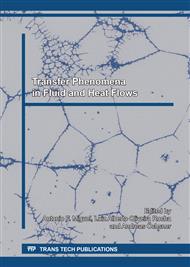[1]
P. Koštial, I. Ružiak., Z. Jonšta, I. Kopal, R. Hrehuš, J. Kršková, Experimental method for complex thermo-mechanical material analysis, Int. J. Thermophysics, 31 (2010), 630-636.
DOI: 10.1007/s10765-010-0745-5
Google Scholar
[2]
I. Kopal, P. Koštial, P. Investigation of thermal parameters of materials I, VŠB-TU, Ostrava, (2010).
Google Scholar
[3]
S. Malinarič, P. Dieška, P. Krupa, Modified dynamic plane source method for measuring thermophysical parameters of solids, Int. J. Thermophysics, 33 (2012), 528-539.
DOI: 10.1007/s10765-012-1173-5
Google Scholar
[4]
U. Besson, The History of the Cooling Law: When the Search for Simplicity can be an Obstacle, Sci. Educ-Netherlands, 21 (2012), 1085–1110.
DOI: 10.1007/s11191-010-9324-1
Google Scholar
[5]
K. C. Cheng, Some observations on the origins of Newton's law of cooling and its influences on Thermofluid Science, Appl. Mech. Rev., 62 (2009), 060803.
Google Scholar
[6]
M. Vollmer, Newton's law of cooling revisited, Eur. J. Phys, 30 (2009), 1063.
Google Scholar
[7]
A. Tröster, W. Schranz, General theory of heat diffusion dynamics, Phys. Rev. B, 66 (2002), 1841.
Google Scholar
[8]
X. Maldague, Theory and Practice of Infrared Technology for Non Destructive Testing, Wiley, New York, (2001).
Google Scholar
[9]
J. H. Lienhard, A heat transfer textbook, 4th ed. Mineola, N. Y, Courier Dover Publications, (2013).
Google Scholar
[10]
M. Matejides, Applied mathematics (in Slovak), Matcentrum, Zvolen.
Google Scholar
[11]
M. C. Wendl, Fundamentals of Heat Transfer Theory and Applications, Department of Mechanical Engineering and School of Medicine, Washington University, Saint Louis, (2005).
Google Scholar
[12]
R. P. Feynman, R. B. Leighton, M. Sands, The Feynman Lectures on Physics, Desktop Edition Volume I., New millennium edition, New York, Basic Books, (2013).
Google Scholar
[13]
J. L. Plawsky, Transport Phenomena Fundamentals, CRC Press third ed., Boca Raton, CRC Press, Taylor & Francis Group, (2014).
Google Scholar
[14]
X. P. V. Maldague, Nondestructive Evaluation of Materials by Infrared Thermography, London: Springer London, (1993).
Google Scholar
[15]
M. G. Kondratjev, Reguljarnyj teplovoj režim, Gosstroj, Moskva, (1954).
Google Scholar
[16]
J. Juodvalkis, E. Blaževičius, R. A. Vipartas, Methods of unstable heat transfer calculations and experimental verification, Energetika, 2 (2004), 33-39.
Google Scholar
[17]
P.V. Cherpakov, N. G. Shimko, Regular thermal regime in a multi-layer medium, J. Eng. Phys. Thermophys, 8 (1965), 54-58.
DOI: 10.1007/bf00833677
Google Scholar
[18]
R. Resnick, D. Halliday, J. Walker, Fundamentals of physics, Wiley, New York, (1988).
Google Scholar
[19]
C.T. O'Sullivan, Newton's law of cooling - a critical assessment, Am. J. Phys., 58 (1990), 956-960.
Google Scholar
[20]
J.T. Kim, CH. Lim, J.K. Choi, Y.K. Lee, A method for the evaluation of heat transfer coefficient by optimization algorithm, Solid State Phenom., 124 (2007), 124-126.
DOI: 10.4028/www.scientific.net/ssp.124-126.1637
Google Scholar
[21]
J. Buša, V. Pirč, Š Schrötter, Numerické metódy (in Slovak), Elfa, Košice, (2006).
Google Scholar


